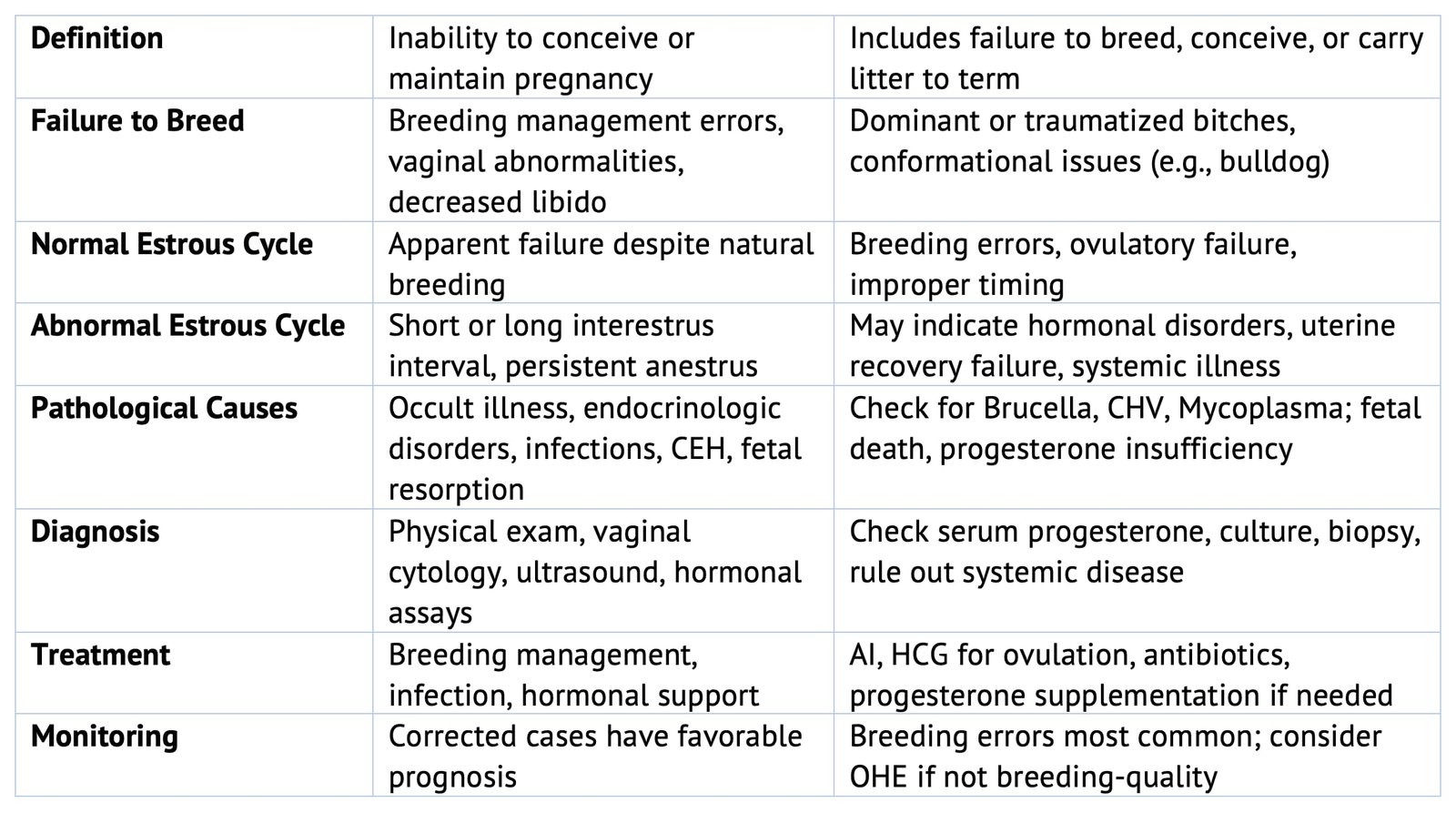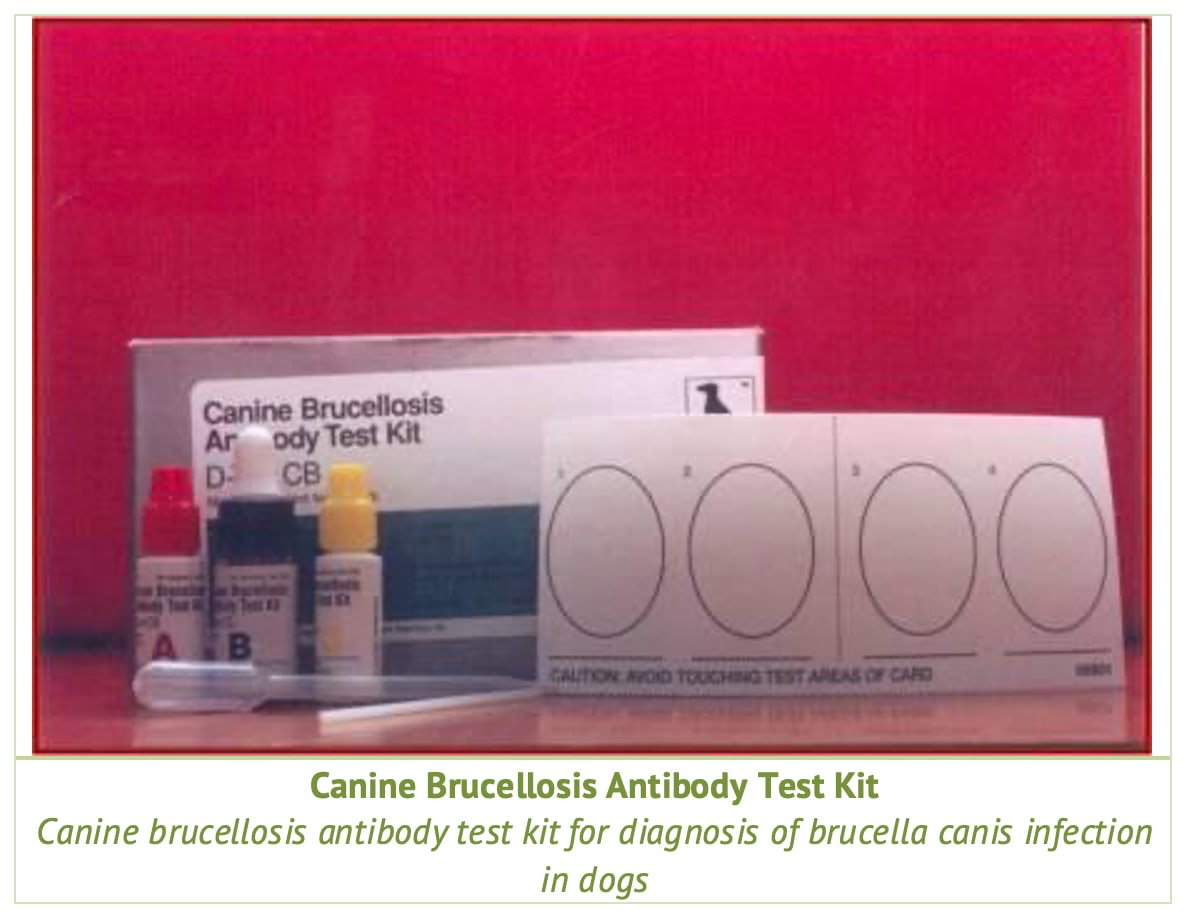TABLE OF CONTENTS
Infertility in Female Dogs
Infertility in female dogs refers to the inability to conceive or maintain a pregnancy despite appropriate breeding efforts.
Definition of Infertility in Female Dogs
- A diminution or absence of ability to produce offspring.
- Includes bitches that fail to breed, conceive or carry a litter to term.
Classified based on reproductive history:
- Failure to breed
- Normal estrous cycle
- Abnormal estrous cycle

Causes and Clinical Signs
Failure to Breed
Breeding management error:s
- Owners often believe breeding should occur on predetermined dates relative to the day of the estrous cycle, e.g., days 9 and 11 or 11 and 13.
- If proestrus is either short or long, predetermined breeding dates may not correspond with behavioral estrus.
Vaginal abnormality that prevents copulation, Decreased libido:
- Bitches that dominate the stud dog
- Bitches that have had a prior traumatic breeding experience.
Abnormal stature or conformation making breeding physically difficult, e.g., English bulldog.
Normal Oestrous Cycle
Consider the following in a bitch with normal inter estrus intervals and duration of proestrus and estrus that breeds naturally and yet apparently fails to conceive or carry a litter to term.
Breeding Management Errors
- If a limited number of breedings occur prior to ovulation, sperm may not be viable when the bitch has mature ova available for fertilization.
- If a bitch is breed after the cytologic diestrual shift (as determined by vaginal cytology) the fertile period may be missed.
Ovulatory failure: Evaluation of progesterone concentration during diestrus can be used to retrospectively determine that a bitch has ovulated and has functional corpora lutea.
Serum progesterone concentration ranges from 5-80 mg/ml during diestrus if the bitch has normal ovarian function, irrespective of whether or not she is pregnant.
Pathological Conditions
Occult illness: Clinical signs such as polyuria, polydipsia, poor coat quality, weight loss or gain and changes in appetite warrant investigation.
Endocrinologic diseases such as hyper or hypoadrenocorticism, diabetes mellitus and hypothyroidism can cause reproductive failure.
Infectious disease: All breeding bitches are screened for Brucella canis prior to breeding.

Infection with canine herpesvirus can cause failure to conceive, fetal loss in utero, stillborn fetuses and early neonatal death Low grade, occult bacterial infection of the uterus may cause conception and / or implantation failure.
Bacteria of the normal vaginal flora do not cause infertility, but:
- Overgrowth of vaginal mycoplasma has been suspected as a cause of conception failure.
- More investigation is warranted in the interpretation of vaginal cultures for Mycoplasma sp. And the possible relationship of vaginal mycoplasmosis and infertility.
Cystic endometrial hyperplasia: conception and / or implantation failure: Fetuses that die in utero during the first 1/3 – ½ of gestation may degenerate and be resorbed without outward sings.
Resorption or abortion: Some bitches may exhibit malaise, fever, inappetence and a sanguineous or purulent vaginal discharge.
Fetuses that die later in gestation will usually be aborted. Causes of fetal death include maternal infectious disease, endometrial disease; developmental defects in the fetuses and progesterone insufficiency.
Hypotuteoidism is a failure of corpora ltuea to secrete adequate progesterone.
Decrease in progesterone may be secondary to other factors such as fetal abnormalities, placentitis and exogenous glucocorticoid therapy.
A bitch can partially resorb or abort a a litter and the remaining healthy fetuses may go to term.
An incorrect diagnosis of pregnancy by palpation may cause an owner to inaccurately believe resorption has occurred when the bitch fails to whelp a litter.
Abnormal Oestrus Cycle
- Bitches that cycle as frequently as every four months are abnormal.
- A short inter estrus interval may occur if a bitch fails to ovulate.
- It a bitch ovulates with each cycle, it is possible that the uterus has insufficient time to recover from the trophic effects of progesterone before the next cycle occurs.
- Cystic endometrial hyperplasia may develop as a result of repeated diestrual progesterone influence.
- An inter estrus interval > 10 months is abnormal.
- Some breeds, such as the Basenji, normally cycle one once per year.
If the inter estrus interval is sporadic or prolonged in a bitch that fails to conceive, consider the following:
- Underlying illness, including endocrinologic disease or neoplasia.
- Drug administration such as glucocorticoids and antineoplastic agents.
Normal infrequent cycling older bitch (>6–8 years):
- There is a significant decrease in conception rate, number of puppies whelped, and puppy viability after 8 years of age.
- Aged bitches have a high incidence of cystic endometrial hyperplasia and decreased frequency of ovulation.
Persistent anestrus should be evaluated in a bitch over 2 years of age that has not had a pubertal estrus or in bitches that apparently cease estrus cyclicity.
- Estrous cycles may occur without outward signs of proestrus or estrus (silent heat).
- Underlying systemic disease may cause persistent anestrus.
- If a bitch fails to show pubertal estrus an inter sex condition may exist.
- Premature ovarian failure may be a cause of persistent anestrus.
Diagnosis
Obtain a complete medical and reproductive history. Perform a through physical examination with vaginal and rectal palpation.
Perform a vaginoscopic examination to determine if congenital abnormalities exist.
Rule out brucellosis. All bitches should be screened for Brucella canis prior to each breeding. Stud dogs should be screened every 6 months and bred only to tested bitches.
Determine ovulation timing to detect management errors. Screen for underlying illness with a haemogram, biochemistry profile and urinalysis.
Consider hormonal assays of which progesterone determination is the most useful. When determined in diestrus, serum progesterone concentration >5 ng/ml indicates the bitch ovulated and has functional corpora lutea. If hypoluteoidism is suspected, serum progesterone concentration should be monitored weekly. Gestational serum progesterone concentration <2 ng/ml is inadequate to support pregnancy. A silent, ovulatory estrus can be documented.
Ultrasonography helps characterize uterine changes, detects pregnancy (approximately 20–23 days after last breeding), which is important in differentiating conception failure from fetal resorption. Provides indication of fetal viability and estimation of litter size. Allows differentiation of pyometra from pregnancy. May detect other uterine or ovarian disease, e.g., neoplasia.
A guarded swab may be used to culture the cranial vagina. Isolation of aerobic bacteria is difficult to interpret since normal flora is often recorvered. Mycoplasma sp. Can be isolated with special handling, but positive growth may represent normal flora.
In a bitch with resorption of fetuses or abortion, test for canine Herpesvirus (CHV). Viral isolation can be achieved from swab samples of vaginal discharge. Aborted fetal tissues and placentae should be chilled (not frozen) and submitted for CHV isolation. Serum antibody titers to CHV are relatively low (i.e., 1:2 upto 1:32) and generally persist only 4-8 weeks after exposure. Paired titers are suggested but any positive titer, coincident with clinical signs, is significant.
Exploratory laparotomy is an aggressive but helpful diagnostic step. The uterus, ovaries and areas of the oviducts can be directly palpated.
Obtain uterine biopsies for evaluation of endometrial disease. Obtain cultures for aerobic bacteria and Mycoplasma sp; positive from the uterus is significant.
Treatment
The key to treatment is finding the cause of apparent infertility and correcting the problem.
In a bitch that fails to breed consider the following:
- Correct a vaginal stricture or other anomaly.
- Time ovulation to determine if the breeding is managed correctly.
- Change the environment.
- If either animal is apprehensive provide an alternate setting.
- The stud dog may overcome an aggressive bitch if she is brought into his environment.
- Artificial insemination may be necessary if a cause cannot be found.
For bitches with normal estrous cycles, try the following:
- A test breeding should be conducted during the next estrus.
- Attempt natural matings with an aggressive stud dog that has recently sired litters.
- Ovulation timing is performed so that breedings occur during the period of optimum fertility.
- If a bitch has ovulation failure, ovulation can be hormonally induced.
- Give Human Chorionic Gonadotropin (HCG) 500–1, 1,000 IU IM, SQ.
- The HCG is injected at the point of maximal vaginal cornification.
- If a large number of Mycoplasma sp. Are recovered with a cranial vaginal culture, systemic antibiotics (chloramphenicol, tetracycline or enrofloxacin) are given for 2–3 weeks. The ideal time for such treatment is just preceding the next estrous cycle.
- Antibiotic therapy is discontinued when behavioral estrus begins.
- For concern during pregnancy when hypoluteoidism has been documented during a prior gestation and serum progesterone concentration is low (2–5 ng/ml) consider progesterone supplementation. Inappropriate supplementation may induce masculinization of female fetuses causing urogenital system development. If progesterone supplementation is continued beyond days 50–55 of gestation, spontaneous parturition may be inhibited. Various protocols for progesterone supplementation have been suggested.
- Repositol progesterone in propylene glycol: 2 mg/kg IM twice weekly until day 50 of gestation.
- Progesterone in oil 0.5 mg/kg IM weekly until I week before date of expected delivery.
Patient Monitoring
- When a cause for the apparent infertility can be found and corrected the prognosis for fertility is favorable.
- Breeding management error is the most common cause of apparent infertility in female dogs and the easiest to correct.
- Owners may not wish to pursue a thorough diagnostic evaluation of a bitch that is of marginal breeding quality and ovariohysterectomy may be considered.

